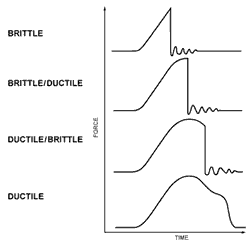Impact testing is testing an object's ability to resist high-rate loading. An impact test is a test for determining the energy absorbed in fracturing a test piece at high velocity. Most of us think of it as one object striking another object at a relatively high speed.
Why is Impact Testing Important?
Impact resistance is one of the most important properties for a part designer to consider, and without question, the most difficult to quantify. The impact resistance of a part is, in many applications, a critical measure of service life. More importantly these days, it involves the perplexing problem of product safety and liability.

One must determine:
- The impact energies the part can be expected to see in its lifetime
- The type of impact that will deliver that energy, and then
- Select a material that will resist such assaults over the projected life span
Molded-in stresses, polymer orientation, weak spots (e.g. weld lines or gate areas), and part geometry will affect impact performance. Impact properties also change when additives, e.g. coloring agents, are added to plastics.
Ductile vs. Brittle
Most real world impacts are biaxial rather than unidirectional.
Further complication is offered by the choice of failure modes: ductile or brittle. Brittle materials take little energy to start a crack, little more to propagate it to a shattering climax. Other materials possess ductility to varying degrees. Highly ductile materials fail by puncture in drop weight testing and require a high energy load to initiate and propagate the crack.
Many materials are capable of either ductile or brittle failure, depending upon the type of test and rate and temperature conditions. They possess a ductile/brittle transition that actually shifts according to these variables.

What Testing Equipment is critical for Impact Test results
Pendulum Impact Testing machines and Drop Weight Testers are both critical to validating the performance of materials. However, there are differences between the two instruments that determine which application is best suited to each.
Difference between a Pendulum Impact Testing machine and a Drop Weight Tester
Each test uses a different approach.
As the name implies, a pendulum uses a hammer (mass) rotating on an axis to strike a sample. The point of impact occurs at the lowest point of the pendulum arc when the force is only directed in the horizontal plane.
In a drop weight tester, a mass is dropped on a sample, and the impact is measured using a load cell. The force of impact is directed in the vertical plane only. Unlike pendulums, drop towers can also measure deformation, thus giving more information about the material properties.
The first step to determining whether to use a pendulum or a drop tower is knowing the standards that the test needs to comply with.
There are two traditional standards for measuring impact resistance: the Charpy pendulum impact test (ISO 179/ASTM D6110) and the Izod test (ISO 180/ASTM D256). These two test methods are used to certify the impact resistance of a variety of materials, including metals as well as plastics, resins, and composites. They are often found on data sheets to show that the material conforms to its specifications.
Neither Charpy nor Izod test standards allow for the use of drop towers except for the ISO 179-2 standard. This limitation means that only pendulum impact testers may be used to certify products according to ISO 179-1/ASTM D6110 and/or ISO 180/ASTM D256.
Drop Weight testers can still be used to perform Charpy and Izod tests for internal purposes (e.g., to compare products or investigate material properties). Not only that. Drop towers offer greater flexibility than pendulums when it comes to testing configurations and can test according to a variety of standards, including:
- ISO11343 – Adhesives – Peel Impact Test Method
- ISO 8256 – Determination of Tensile Impact Test
- ISO 6603-2 and ASTM D3763 - Puncture Resistance of Plastic
- ASTM D7136 - Compression After Impact
Drop towers can also be used to perform component tests that go beyond the requirements of international standards.